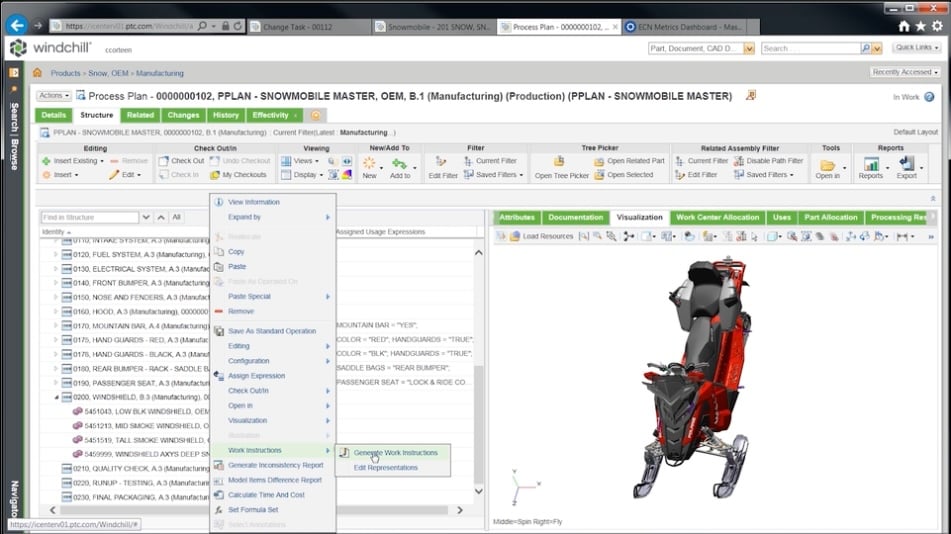Updated: October 15, 2024- 9 min read
The Product Lifecycle describes the stages a product goes through from conception to retirement. The Product Management Lifecycle is the key to understanding and effectively managing these stages and is essential to the success and longevity of any product.
Product Strategy Template
The higher you go up on the Product career ladder, the more strategic skills matter. This template helps you define the why and how of product development and launch, allowing you to make better decisions for your users, team, and company.
Download Template
What Is the Product Lifecycle?
The Product Lifecycle is a model that describes the stages a product goes through from conception to retirement. The concept was introduced by Raymond Vernon in 1966 and has since become a fundamental concept in Product Management.

The product lifecycle phases in the image above—introduction, growth, maturity, and decline—break down the life of a product that is on the market after launch. Of course, Product Managers start interacting with products months, if not years, before the product launch, but we’ll get to that a little later.
Product Lifecycle Stages
Introduction:
The product is launched into the market, with sales starting slow as awareness and adoption build.Growth:
The product experiences rapid sales growth as more customers adopt it, and demand increases.Maturity:
Sales reach their peak, and the product becomes widely accepted in a saturated market.Decline:
Sales begin to decrease as the product loses relevance or is replaced by newer solutions.
Customer motivations at each stage of the Product Lifecycle
The attitudes, expectations, and budgets of target customers differ at every stage of the product life cycle. These specific desires drive product adoption and then, in some cases, spell the end for a given product. Consider the example of skinny jeans:
In the Introduction phase, only early adopters or trendsetters buy the latest, often high-priced fashion, driven by the desire to be unique and ahead of the curve.
During Growth, as the trend gains popularity, a broader audience embraces it, motivated by a desire to be fashionable and fit in with the current style.
In Maturity, the trend reaches its peak, becoming mainstream; most consumers purchase skinny jeans because it’s practical—they’re widely available at affordable prices.
Finally, in the Decline stage, trend-conscious consumers move on to newer styles, while bargain hunters or those indifferent to trends buy the clothing at discounted prices, motivated by value rather than style.
What is Product Lifecycle Management (PLM)?
Product Lifecycle Management (PLM) is the process of overseeing a product from its initial concept through design, development, launch, and eventual retirement. It provides a structured approach to managing all phases of a product’s life, ensuring that each stage is optimized for efficiency, cost control, and quality.
PLM acts as the central framework that supports the product lifecycle, ensuring smooth transitions between each phase and helping teams respond quickly to changes or issues as they arise. It integrates people, processes, business systems, and information, making it a comprehensive model for managing the entire lifecycle. By using PLM, teams can streamline workflows, track progress, and ensure the product meets market demands at every stage.
How PLM Relates to the Product Lifecycle
Product Lifecycle Management (PLM) plays a critical role in managing each stage of the product lifecycle—from inception through growth, maturity, and decline. While the product lifecycle outlines the phases a product experiences in the market, PLM ensures efficient handling of the product’s design, development, and updates throughout those phases.
Inception
During the inception phase, product managers work on ideation, market research, and conceptualizing the product. Tasks include:
Aligning product concepts with business goals
Gathering user needs and conducting feasibility analysis
Building early-stage prototypes and conducting initial validations
Focus: Validate the product idea, ensure team alignment, and use PLM to centralize early data and feedback.
Introduction
In the introduction phase, product managers are responsible for launching the product to market. PMs must:
Manage feature delivery and ensure product readiness
Track early user feedback and adjust marketing tactics
Focus: Ensure a smooth launch by closely monitoring product adoption and adjusting based on early feedback.
Growth
As the product gains users, Growth Product Managers focus on scaling the product. Key tasks include:
Monitoring customer feedback and usage patterns
Prioritizing new features and improvements
Managing version control and iterative releases
Focus: Scale the product successfully while maintaining responsiveness to customer needs and competition.
Maturity
When the product reaches maturity, product managers aim to maintain market share and optimize performance. Tasks include:
Streamlining operations for cost efficiency
Exploring market diversification or feature extensions
Monitoring churn and customer retention metrics
Focus: Maximize profitability and longevity through optimization and incremental updates.
Decline
In the decline phase, product managers decide whether to retire the product or find ways to extend its lifecycle. Product Managers are in charge of:
Analyzing market trends to inform exit strategies
Managing feature deprecation and customer transitions
Planning product sunsetting or migration to newer versions
Focus: Ensure a smooth phase-out or transition while minimizing customer disruption.
Agile Product Lifecycle Management
Agile Product Lifecycle Management (PLM) applies agile methodologies to the management of a product’s lifecycle, enabling teams to be more flexible, iterative, and responsive to customer needs. Agile PLM emphasizes rapid iterations, continuous delivery, and frequent feedback loops, which are critical for software and SaaS products.
Key aspects of Agile PLM include:
Iterative development: Break down the product lifecycle into short sprints.
Frequent feedback: Incorporate customer input in real time to refine features.
Flexibility: Adapt the product roadmap quickly based on changing market conditions and priorities.
Agile PLM ensures continuous product improvement and customer satisfaction through regular updates, reducing the risk of product stagnation. By staying responsive to market trends and customer needs, teams can keep their product aligned with user expectations and extend its lifecycle.
Product Lifecycle Management Benefits
Product Lifecycle Management (PLM) offers a range of benefits, particularly for software and SaaS products, enabling teams to streamline processes and ensure long-term product success. Key advantages include:
Improved Collaboration: PLM provides a centralized system that allows cross-functional teams (engineering, marketing, support) to collaborate effectively.
Faster Time-to-Market: By optimizing workflows and version control, PLM helps reduce development cycles.
Cost Efficiency: PLM allows better resource allocation, reducing unnecessary spending throughout the lifecycle.
Informed Decision-Making: Access to real-time data helps product managers make data-driven decisions at each stage.
Consistency and Compliance: PLM ensures that products meet quality standards and regulatory requirements consistently.
These benefits help manage the complexity of software products, ensuring smooth transitions through each lifecycle phase.
Key Features of PLM Systems
PLM systems offer several important features to manage the product lifecycle efficiently:
Requirements Management: Organizes and tracks requirements, ensuring development aligns with business goals.
Version Control: Manages multiple versions and tracks changes for software updates and rollbacks.
Agile Workflows: Supports iterative development and helps manage sprints, backlogs, and collaboration.
Traceability: Ensures that changes can be traced to their origin, aiding in issue resolution.
Digital Threads: Provides continuous, interconnected data flow across the entire lifecycle, enhancing traceability and collaboration between teams.
Digital Threads in Product Lifecycle Management
Digital threads are crucial in Product Lifecycle Management (PLM), offering an interconnected flow of data throughout the product's lifecycle. For software and SaaS, this means seamless traceability from design to customer feedback. Digital threads boost collaboration, offer real-time insights, and reduce errors by maintaining a single source of truth. They ensure every change, update, or issue is documented and accessible, allowing teams to respond faster and make better-informed decisions.
For example, imagine a new feature in a SaaS platform. During development, the team notices a bug linked to an earlier design choice. With the digital thread, they can trace the bug back to its origin, viewing design notes and code changes. This visibility allows them to fix the issue quickly while understanding its broader impact.
Many modern PLM tools incorporate elements of digital thread technology (DTT) to offer seamless integration across teams, but not all are fully designed to support the depth of traceability and interconnected data that digital thread software provides. See below for a list of PLM tools to see which ones include DTT.
PLM Software for Product Teams
There are various PLM tools available for software and SaaS teams, each with its own strengths and features.

Here are a few popular ones:
Jama Connect: A requirements management and traceability tool. It offers robust traceability features to ensure that changes are well documented, helping teams stay aligned as they move through development and iterations.
Atlassian Jira: Primarily an agile project management tool, Jira supports lifecycle management through integration with various development and DevOps tools, providing visibility into project progress.
PTC Windchill: A comprehensive PLM system that incorporates digital thread technology, PTC Windchill enables seamless data flow across the entire lifecycle. This ensures end-to-end traceability, connecting design, development, and post-launch activities. It is ideal for teams looking to integrate product data and manage complex product portfolios.
Siemens Teamcenter: Siemens Teamcenter offers a full PLM solution with integrated digital thread capabilities, providing teams with a holistic view of product data. It connects cross-functional teams, allowing real-time collaboration from design to customer feedback, ensuring that every decision is informed by up-to-date data.
GitLab: A DevOps platform that combines source control, CI/CD pipelines, and lifecycle management. GitLab enables teams to manage the entire software development lifecycle from code development to deployment. Its strong traceability features help teams stay on top of changes and ensure continuous delivery.
Each tool supports different aspects of the product lifecycle, but not all have the full digital thread integration that enables seamless, real-time data connectivity across all stages.
From the early stages of ideation and introduction through growth, maturity, and eventual decline, PLM provides a structured approach that enables teams to optimize each phase. By leveraging the right tools and strategies, teams can not only improve collaboration and streamline processes but also make data-driven decisions that enhance product performance and extend its lifecycle.
Whether you're managing a new launch or steering a product through its twilight years, effective PLM will ensure you stay ahead of the competition and meet market demands. Ultimately, a well-executed PLM strategy is the difference between a product that thrives and one that fades away.
Product Launch Checklist
Launch is a critical time that can make the difference between product success and failure. Use this checklist to make sure nothing falls through the cracks.
DOWNLOAD CHECKLIST
Updated: October 15, 2024





